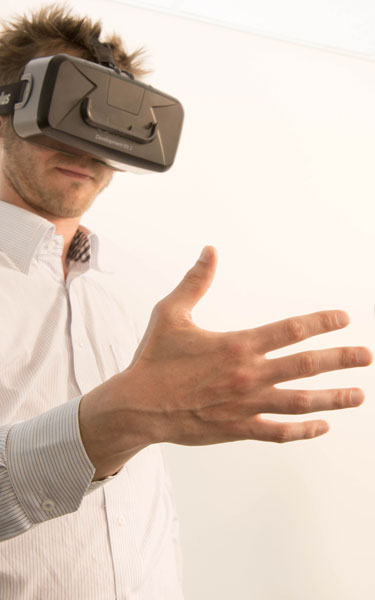by Ludovic Hoyet (Inria)
In years to come, the development of new immersive media (including digitalisation of industries) will lead to a massive spread of avatars, the users’ representation in the virtual world. By leveraging the complementary expertise of six Inria teams, the project “Avatar” aims to design the next generation of avatars for digital worlds in order to reach new levels of user embodiment in and through their virtual replica.
Owing to the massive dissemination of consumer-grade head-mounted displays, the development of novel immersive media is speeding up the process of digitisation, in domains ranging from entertainment industries, to sports and industrial training simulations, and medical cybertherapies. In such applications, modelling easily and efficiently the virtual counterpart of physical products or processes, i.e., the digital twins, is therefore becoming increasingly crucial. In particular, with the development of HMDs, users do not see their physical body. Therefore, the representation of users in the virtual world, i.e., their avatar, is now becoming a major requirement for making people live a truly immersive and effective experience, and raises questions about how well users can be embodied in their avatars, a concept called the “sense of embodiment” [1]. While both the visual aspect and motor capabilities of avatars have been shown to affect the ability of users to embody in avatars [2], they still often fail at conveying a strong sense of embodiment or interaction. This failure can be explained by current technological limitations in acquiring, simulating and controlling avatars, but it is also largely due to a lack of perceptual understanding about how we perceive and interact with avatars.

The Inria project “Avatar” aims to design the next generation of avatars for digital worlds in order to reach new levels of user embodiment in and through their virtual replica. © Inria / Photo J.C. Moschetti.
The objective of the Inria Avatar project is to expand the limits of perception and interaction through avatars in immersive media. In particular, we believe that the next generation of avatars will need to provide a stronger sense of embodiment in order to enable natural and expressive interactions with virtual worlds, to better feel the digital content by means of multisensory feedback, and to better share virtual experiences. Such objectives raise multiple scientific challenges, e.g.: How to acquire and model faithful or stylised representations of the users? How to render and animate them in highly expressive or symbolic ways? How to enable complex 3D interaction capabilities? How to design and identify the best means of conveying multisensory information to users through their avatar? To address these multidisciplinary challenges, we are bringing together the complementary expertise of six Inria teams at all levels [L1]: Graphdeco (Rendering,Inria Sophia Antipolis Méditerranée), Hybrid (3D Interactions and Virtual Reality, Inria Rennes Bretagne Atlantique), Loki (Human-Computer Interaction, Inria Lille Nord Europe), MimeTIC (Animation and Biomecanics, Inria Rennes Bretagne Atlantique), Morpheo (Computer Vision, Inria Grenoble Rhone-Alpes), Potioc (Human-Computer Interaction, Inria Bordeaux Sud-Ouest). Our scientific challenges are also strongly interconnected with fundamental knowledge in perception, psychology and neuroscience, addressed in collaboration with our partner Prof. Mel Slater (University of Barcelona), world expert on fundamental psychological and neuroscience aspects of “virtual embodiment”.
The general philosophy of this project, which started in May 2018, is to develop the next generation of avatars by using a multidisciplinary approach to address complex problems related to the acquisition, rendering, animation, and multi-sensory feedback and interactions envisaged for avatars, while characterising the perceptual experience and the resulting sense of embodiment across the whole pipeline. While the benefits of creating interactive and embodied avatars can be demonstrated for numerous domains of applications, ranging from entertainment, to training, education or health, our project focuses on two key demonstrators: avatars for immersive cinema, in collaboration with our industrial partner Technicolor, and avatars for industrial training, in collaboration with our industrial partner Faurecia. Even though different use-cases will require specific assets and demonstrators, our goal is to ensure that they will rely on the same core technological output to allow for their use in new application domains in the future.
This unique opportunity to bring together all the scientific and technological expertise needed to cover the entire technical pipeline as well as the necessary perceptual/psychological perspective of “virtual embodiment” should enable the creation of the next generation of avatars. By making it easy to use virtual representations of users in the majority of immersive applications, ranging from home to industrial setups, we believe that avatars should become an effective tool truly creating new industrial and entertainment challenges and applications, as well as fostering novel multidisciplinary collaborations with international academic and industrial partners.
Link:
[L1] http://avatar.inria.fr
References:
[1] K. Kilteni, R. Groten and M. Slater. The Sense of Embodiment in Virtual Reality. In Presence 21(4), 2012.
[2] F. Argelaguet, L. Hoyet, M. Trico, A. Lécuyer. The Role of Interaction in Embodiment: The Effects of the Virtual Hand Representation. In IEEE VR 2016.
Please contact:
Ludovic Hoyet, Inria, France
+33 2 99 84 25 21











